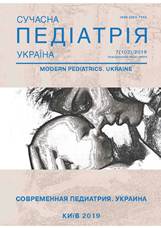Differential diagnostics and treatment tactics of pediatrician at repeated episodes of broncho obstructive syndrome
Keywords:
broncho-obstructive syndrome, recurrent episodes, children, differential diagnostics, bronchial asthmaAbstract
The article presents the problem of bronchial obstructive syndrome in children due to the prevalence, complexity of differential diagnosis in the case of recurrences episodes.Given that bronchial obstructive syndrome may be present with a wide range of problems (upper digestive tract,cardiovascular, hereditary and congenital bronchopulmonary pathology, etc.), this is differentiates the need for a clinical interpretation of each situation in particular. Particular attention is paid to the importance of a full examination of the child, detailed anamnesis (disease, genetic, allergic), careful choice of the volume of necessary examinations. It does not decrease the relevance of a probable diagnosis of bronchial asthma based on taking into account the frequency of bronchial obstructive syndrome, burdensome allergic and/or genetic history, individual laboratory parameters (eosinophilia, elevated Ig E levels in the blood). High risk of bronchial asthma in a child is the basis for the trial anti-inflammatory therapy using antileukotriene drugs, obvious referral of the patient to the allergist.
References
Abdullch Al-Shamrani, Khalid Badais, Ayed Alenazi et al. (2019, Jun). Wheezing in children: Approaches to diagnosis and management. Int Pediatr Adolesc Med.6(2): 68-73. https://doi.org/10.1016/j.ijpam.2019.02.003; PMid:31388550 PMCid:PMC6676316
Bronкhial’na astma v pediatrychniy praktytsi: pohlyad providnykh spetsialistiv (2017, Traven). Zdorov'ya Ukrayiny. 2.
Corinne A. Riddell, Niranjan Bhat, Louis J Bont, William D Dupont et al. (2015). Informing randomized clinical trials of respiratory syncytial virus vaccination during pregnancy to prevent recurrent childhood wheezing: A sample size analysis. PLoS One. 10(5): e0125422.
Esposito S, Ierardi V, Daleno C, Scala A, Terranova L, Tagliabue C, Rios WP, Pelucchi C, Principi N. (2014, Oct 18). Genetic polymorphisms and risk of recurrent wheezing in pediatric. BMC Pulm Med.14:162. https://doi.org/10.1186/1471-2466-14-162; PMid:25326706 PMCid:PMC4210469.
Granell R, Henderson AJ, Sterne JA. (2016, Oct). Associations of wheezing phenotypes with late asthma outcomes in the Avon Longitudinal Study of Parents and Children: A population-based birth cohort. J Allergy Clin Immunol. 138(4): 1060-1070. https://doi.org/10.1016/j.jaci.2016.01.046; PMid:27106203 PMCid:PMC5052126
Stephen O, Le Souef P. (2015). The wheezing child: an algorithm. AFM. 44;6: 360-364.
Tenevo L, Piazza M, Piacentini G. (2016, Jan). Recurrent wheezing in children. Trans Pediatr. 5(1): 31-36.
Turunen R, Vuorinen T, Bochkov Yu, Gern J, Jartti T. (2017, Jun). Clinical and virus surveillance after the first wheezing episode: special reference to rhinovirus A and C species. Pediatr Infect Dis J.36(6): 539-544. https://doi.org/10.1097/INF.0000000000001495; PMid:28027280 PMCid:PMC5472222
Wi CI, Krusemark EA, Voge G, Sohn S et al. (2018, Jun). Usefulness of Asthma Predictive Index in Ascertaining Asthma Status of Children Using Medical Records: An Explorative Study. Allergy.73(6):1276-1283. https://doi.org/10.1111/all.13403; PMid:29319899 PMCid:PMC6326096. Epub 2018 Feb 7.
Issue
Section
License
The policy of the Journal “MODERN PEDIATRICS. UKRAINE” is compatible with the vast majority of funders' of open access and self-archiving policies. The journal provides immediate open access route being convinced that everyone – not only scientists - can benefit from research results, and publishes articles exclusively under open access distribution, with a Creative Commons Attribution-Noncommercial 4.0 international license (СС BY-NC).
Authors transfer the copyright to the Journal “MODERN PEDIATRICS. UKRAINE” when the manuscript is accepted for publication. Authors declare that this manuscript has not been published nor is under simultaneous consideration for publication elsewhere. After publication, the articles become freely available on-line to the public.
Readers have the right to use, distribute, and reproduce articles in any medium, provided the articles and the journal are properly cited.
The use of published materials for commercial purposes is strongly prohibited.

